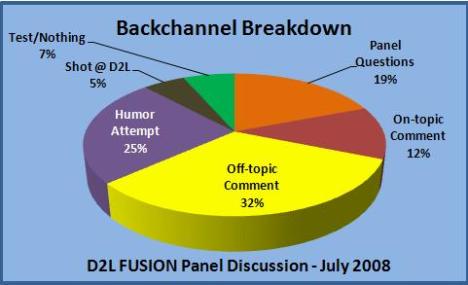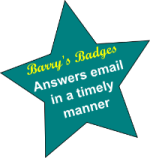I participated in a panel discussion during the Desire2Learn FUSION Conference during July in Memphis (FUSION08D2L). The other panelists were Robbie Melton, Stephen Downes, and Michael Feldstein. Our topic was “What would you like to see happen in the future of e-Learning?” Each panelist took approx 5 minutes to share some thoughts with the lunch-time audience about one topic that was near and dear to them regarding the future of e-Learning. After those opening comments, the floor was opened to the audience to either ask questions of the panelists or make comments about the opening remarks.
We used Stephen’s chat function from his website to create a backchannel that was displayed on two large screens, one on each side of the front of the hall where the panelists were seated. Out of curiosity, I decided to take a look at the chat archives and analyze the types of entries that were made. Although there were a couple of premature postings, I started counting at 12:27:21 PM which is when posts started coming in for the panelists even though the opening comments were still being completed. For my analysis, the first posting was by Hiro Sheridan of Oral Roberts University. The last posting was at 13:16:21 by the ever-popular Anymouse (Stephen’s default username for those who don’t enter one). Altogether, I counted 167 posts from point A to point B.
This presentation was also being streamed live on the Internet using UStream.tv (archive here). There were only a few questions that were asked by audience members using the two microphones that were available in the room, and of course there is no archive of those questions except for what you can hear on the UStream recording. Of the 167 posts in the backchannel, it is impossible to know how many of them came from people in the room with us and how many came from the 50+ people who were viewing the Ustream feed (which could have also included people in the room who opened the streaming video page on their laptops). In other words, questions and comments probably did come from anyone and anywhere.
I arbitrarily categorized the backchannel posts into one of the following six categories:
- Panel questions: these were specific questions that were asked of the panel members that appeared to be serious in nature. There were a total of 32 of these questions. Examples:
- How will MUVEs like Second Life impact education in the next five years?
- Do you know of any study where K-12 online students were surveyed to see if they would be interested in an online degree environment?
- On-topic comment: here an audience member was making a comment about something that had been discussed by the panelists, or related to one of the questions asked by other audience members. It was deemed to be on-topic if it related to the future of e-Learning. There were 20 of these comments. Examples:
- I would like to see truly adaptive eLearning systems — different paths for different learning styles … and a system that supports this well.
- Laggards have just started to waste epic amounts of time and money on my campus and they do not care and not interested in learning…UGH
- Off-topic comment: this was the largest category and included many comments about the nature of the panel discussion and the use of the backchannel, as well as where to get the best BBQ in Memphis, and other idle chatter. There were 55 of these comments. Examples:
- Wow, this is why we don’t want students having laptops in classrooms I guess
- To really wreck a panel put up a backchannel
- The Net gen student works this way ALLLLL the time…three windows and listening…the speaker has to “join in”
- Humor attempt: there were 40 posts that I categorized as (mostly) lame attempts at humor. Keep in mind that this was a room full of education professionals, not high school kids trying to impress their friends. Examples:
- Play Freebird
- I am going to get a patent on “Anymouse” tomorrow! And sue Stephen the next day.
- Can someone please bring toilet paper to stall 3 in the men’s room?
- Shots @ D2L: a few people decided that it was an opportune time to direct some sort of put-down at D2L. Most of these could have easily fallen into category 4 (humorous), and overall I think D2L was very much NOT bothered by the shots across the bow, but I felt that given the nature of a D2L-hosted event that these comments needed to have a category of their own. There were 9 such comments. Examples:
- Did D2L open their API yet?
- API, what’s an API? –signed, John Baker
- john baker, who’s john baker?
- The last category is sort of an Other for those empty posts or those that were clearly just testing to see how the backchannel system worked. There were 11 of these posts. Examples:
- does html work in this thing
- I guess HTML does work in this thing
According to my (admittedly subjective) analysis, only about 31% of the backchannel entries were productive. In my opinion, only the first two categories listed above can be considered productive. I was not at all bothered by the use of the backchannel, in fact I was rather intrigued by the whole thing. So much so that I probably spoke a whole lot less than I am usually inclined to do since I was rather busy watching everything else that was going on. I was also able to see the chat postings on Stephen’s site as they were coming in, which was often a bit prior to the ten seconds that each message was displayed on the screen. In other words, I was oftentimes reading ahead and not paying attention to the task at hand.
One additional observation has to do with the progression of the posts during the approx. 50 minutes that posts were being made to the backchannel. During the first 20 minutes, there were only 6 posts, 5 of which were productive (related to the presentation topic). During the third ten minute period, there were 26 productive posts and 22 non-productive posts. During the fourth ten minute period, there were 12 productive posts and 44 non-productive posts. During the last ten minute segment there were 9 productive posts and 47 non-productive posts. As my six-year-old might say, “I see a patteren” (sic) there.
I hope you weren’t expecting a brilliant conclusion to this piece, because there isn’t one. I’m not going to make suggestions about how a backchannel could be used more productively, although I would appreciate some comments that might give other perspectives on this use of a backchannel or others that you are familiar with. Was this a train wreck, or more like a game of bumper cars?
Filed under: Conference, Read/WriteWeb | Tagged: backchannel, Desire2Learn, FUSION08D2L |







I was there and it was very uncomfortable. I felt bad for the panel, because people in the audience were reading the back channel’s random comments while the panelists were talking, and then the audience would laugh at totally inappropriate times. I’m sure the panelists thought, “Why are they laughing at what I’m saying? I’m not trying to be funny.” My thoughts ranged from, “Is this supposed to be how it works?” to”Yes, that is both tacky and funny”. At no time did it seem to be adding value to the panel discussion. I think it would have been more relevant if anonymous posts had not been allowed. I hate to sound like a stick in the mud, because many of the comments WERE funny, but the panel was supposed to be a serious discussion.
[…] been meaning to write about this for a while. Barry Dahl has a great post analyzing the back-channel comments from our recent panel discussion with Stephen Downes and Robbie […]
[…] Dahl talks about the “back channel” at conferences (this time at Desire2Learn where I keynoted last year but have not been […]
[…] Dahl talks about the “back channel” at […]
Hello, It’s nice to stumble upon a good site like this one. Do you mind if I used some of the information here, and I’ll put a link back to your blog?